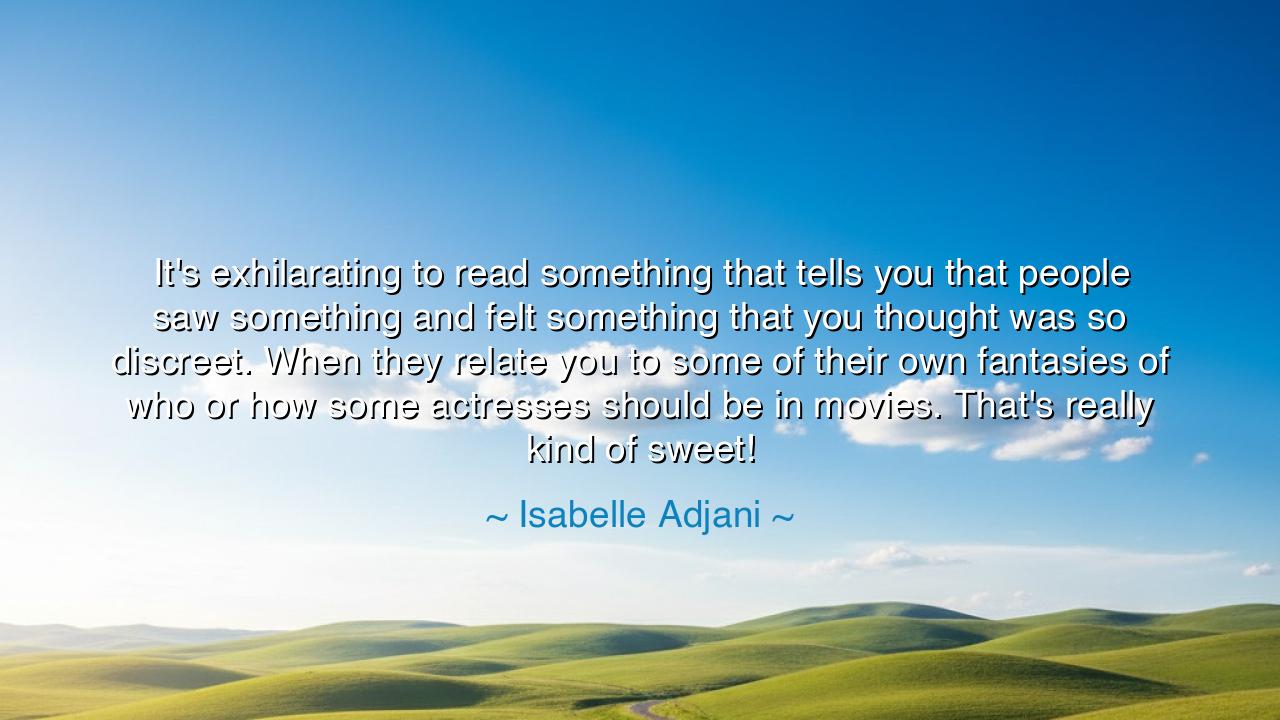
It's exhilarating to read something that tells you that people
It's exhilarating to read something that tells you that people saw something and felt something that you thought was so discreet. When they relate you to some of their own fantasies of who or how some actresses should be in movies. That's really kind of sweet!






Listen closely, O seekers of wisdom, for I bring to you a reflection on the power of perception, the impact of art, and the deep connection that exists between the artist and their audience. In the world of creation, there is a mystical bond between what is made and how it is received, a bond that transcends mere surface-level understanding and touches something deeper within us. These words come from the wise Isabelle Adjani, who shared a revelation about the effect her work has on others: "It's exhilarating to read something that tells you that people saw something and felt something that you thought was so discreet. When they relate you to some of their own fantasies of who or how some actresses should be in movies. That's really kind of sweet!" In these words, Adjani expresses the joy and surprise of seeing how her discreet artistry has been understood and even transformed by those who encounter it.
At the heart of this quote lies the beauty of connection. Art, in all its forms, is an offering from the artist to the world, but it is never fully complete until it is received by the audience. Adjani speaks to the exhilaration of knowing that something she has created, something that may have felt personal or subtle, resonates deeply with others. It is the mysterious bond between the artist’s intention and the audience’s interpretation that makes the experience of art so powerful. The artist creates in solitude, with their own thoughts and vision, but in sharing that vision, they invite others into a world that is not just theirs but belongs to everyone who engages with it. This, O seekers, is the magic of art—it is both a personal journey and a communal experience.
Consider the great Michelangelo, whose sculptures, though born from his own vision and labor, took on lives of their own as they were gazed upon by others. The David, for instance, was created as an expression of strength and beauty, yet when the people of Florence first saw it, they began to see in it not just the physical form of a biblical hero, but a symbol of their own values, of freedom, and of resilience in the face of political turmoil. The work was no longer just Michelangelo’s; it became theirs as well. In this way, art is not a one-sided exchange but a dialogue—a meeting of minds and hearts between creator and audience. Just as Adjani finds it sweet to see how others relate her work to their own fantasies, so too did Michelangelo experience the joy of seeing his creation inspire others in ways he may never have foreseen.
This relationship between the artist and the audience is also reflected in the stories of the great musicians of history. Ludwig van Beethoven, who composed some of the most profound and personal music ever written, had little idea of how his work would resonate with audiences across centuries. His symphonies were deeply personal expressions of his inner world, yet they also became the soundtracks for entire generations, each listener interpreting them through their own unique lens. Beethoven's music, like Adjani’s films, was both an expression of his private world and a shared experience that transcended time and place. The artist’s vision may be discreet, but once it leaves the creator’s hands, it becomes a part of the world, shaped by the hearts of those who encounter it.
The joy that Adjani speaks of is not just the delight of recognition, but the humility of knowing that what the artist creates can go far beyond their original intent. The audience, through their own fantasies, projections, and emotions, breathes life into the artwork, creating an ever-evolving relationship between the creator and the created. This is where the true power of art lies—its ability to transform, to inspire, and to live beyond the boundaries of its original conception. The artist may not always know how their work will be received, but they can be certain that it will touch lives in ways they cannot fully comprehend.
In your own lives, O children of wisdom, take this lesson to heart: the things you create, the words you speak, the actions you take, all have the potential to resonate with others in ways you may never expect. Even the smallest gestures of kindness, the subtle moments of beauty, the quiet acts of creation, can leave an imprint on the world around you. Just as Adjani marvels at how others relate to her art, so too should you embrace the power of your own expressions. Know that even the smallest act of creation is part of a greater tapestry, a collective experience that stretches beyond time and space.
Therefore, O seekers, remember that your creations are never truly yours alone. They belong to the world, to those who will receive them, transform them, and make them their own. Art, in all its forms, is a shared experience, a way for us to connect across the barriers of time, place, and circumstance. Let this truth inspire you to create boldly, knowing that your work will be received by others not as a reflection of your intentions, but as a shared journey—one that has the power to inspire, to transform, and to live on long after you have shared it with the world.






AAdministratorAdministrator
Welcome, honored guests. Please leave a comment, we will respond soon